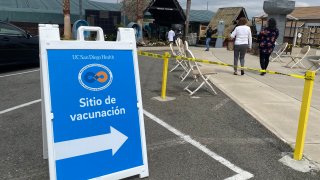
San Diego County is making progress in vaccinating minority communities, but a local biologist believes more can be done.
“We need to do a little more, we need to continue to reach out to these communities, educate them on the importance of vaccines,” said Fabian Rivera-Chavez, an assistant professor at UC San Diego with a PhD.
Rivera-Chavez is working to communicate the importance of vaccination in underserved communities.
“Although Hispanics and Blacks are more likely to die from COVID-19, they’re being vaccinated at lower rates than non-Hispanic whites,” said Rivera-Chavez.
Get top local stories in Southern California delivered to you every morning. Sign up for NBC LA's News Headlines newsletter.
According to educator, there are a variety of reasons for the trend. Accessibility barriers remain, for one, and some people skip their opportunity because they don’t want to miss work.
There is also misinformation on the safety of vaccines. Additionally, vaccine hesitancy still exists in Black communities because of a history of medical abuse and maltreatment.
“We have to confront this by looking at what has happened in the past. Latinos and Hispanic communities are also hesitant to interact with the government, given recent anti-immigrant sentiments,” said Rivera-Chavez.
Vaccination rates for Blacks and Latinos in San Diego County are better than in the U.S. as a whole. Latinos make up 30% of the vaccine-eligible population in the county. Already 26% of the vaccines in the county have gone to Latinos, according to statistics from the County of San Diego.
Meanwhile, 5% of the vaccine-eligible population in San Diego County is Black. According to the county's data, 2.8% of coronavirus vaccines in the county have gone to Black residents.
“We really believe it’s because we’re administering shots in the neighborhoods that they reside in. They’re hearing from our community leaders, a trusted voice,” said JoAnn Fields, Government and Public Relations Director of the Asian Pacific Islander Initiative.
UC San Diego Health has partnered with community groups to bring the shots to minority neighborhoods.
“This matters because we’re not going to see full containment of the virus until we reach a higher rate of vaccination in all populations,” said Rivera-Chavez.
Rivera-Chavez believes a financial incentive may help to reduce the disparities in vaccinations.

